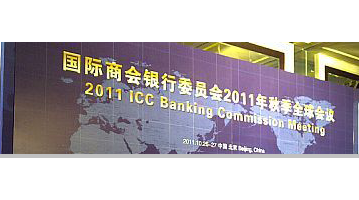The following are notes from my speech given at the “Business Outlook for Trade in Asia: Rise and Rise?” session of the International Chamber of Commerce (ICC) Summit held in Beijing on 28 October 2011.
1. Implications on the rise of Intra-regional Trade
Several data suggests rise of intra-regional trade, even as exports to Europe and the US remains moribund. The points I want to raise from this trend are as follows:
i. Much of intra-regional trade is driven by increase in bilateral trade with China, not necessarily multilateral. Good implications for greater use of RMB.
– Note also that RMB transactions that do not originate and end in China now make up about 8% of RMB transactions on SWIFT network – need to follow this trend and see what’s driving it.
ii. Entire national economies too dependent on China as engine for countering current global downturn – eg Australia, New Zealand, Philippines.
iii. Greater talk of “financial integration” as a theme – ASEAN, Korea, Hong Kong – for payment system integration, for markets integration etc.
iv. The Big Question remains – is intra-regional trade sufficient to counter US/European downturn? My tentative answer is that yes only for countries that record something like 17% and more of their exports being truly intra-regional (or non-EU, US). Some countries like the Philippines and Vietnam have only just entered this category because of recent developments in their export markets.
2. The state of competition between transaction banks
i. The global corporate and transaction banks have been building massive infrastructure and prefer to play the transaction banking game as a infrastructure business, and not a credit driven business – ie. they wished their clients come to them because of the speed of transaction, price per transaction, intra-day liquidity and other features instead of them having to provide credit to secure the transaction banking relationship.
However, the fact that there are too many global players all going after the same corporate and FI customers in the region means that all players will only be as good as the credit they provide their counterparties and corporate customers, no matter how good their technology, for some time to come. Which in turn exposes them to downside credit risks if the regional economies slide.
ii. Also the rise of the regional banks (ANZ from Australia, DBS from Singapore, Maybank and CIMB in Malaysia, ICICI from India, the Thai banks like Bangkok Bank’s focus in Indochina, the Korean and Japanese banks re-focus on Asia) is causing increased competition with the global banks footprint in Asia – also on the basis of credit and lower pricing (cost absorbed to create market share). There will certainly be a fallout in the competition at this level, as not all the regional players who are investing heavily in infrastructure at the moment will succeed in the medium term. But if the music stops, some will be hurt.
iii. Also, even in super-performing China, the smaller players lower down in the banking system do suffer a liquidity crunch because they are focused on SMEs and not the SOEs. They more than others still need and can’t get enough international trade credit. All their key partners have busted their single lender and country limits with them, and these small players can’t service their SME customers export needs enough in a growing market. Story of two inner-Mongolian banks at SIBOS 2011 in Toronto – there precisely because they are exposed to the local SME market in China and need greater access to credit in the absence of strong deposit base and capital.
3. Risk of trade driven credit causing markets to fear Asian banks downturn next
Asian banks have been driving credit up abt 30% yoy in the past two years, on the back of government driven credit expansion to counter global downturn.
But trade driven credit has expanded 15-20% yoy, most of which is in Dollar-based trade, which the banks themselves have to borrow in order to service their customers. Particularly in Korea right now, but potentially Taiwan as well. Raises fears of a 1997 type dollar liquidity crisis – although technically it should be benign as long as the US keeps its own rates down, the equities analysts have been picking up banks in Korea, Taiwan, Philippines and even Singapore that they think are exposed. So, while many banks in Asia are highly liquid, It may be a different story for those that are extending dollar credits to their large exporters are exposed to problems of dollar liquidity.
4. What is the near term prospects for trade growth in Asia?
Follow the inflation! Inflation in Asia is structural more than monetary. Much work to be done on the fronts of supply chain financing, distribution and value chains.
– Rural development in China and India.
– Commodities export supply chains still being developed from source to new consumption economies like China and India
– SME Credit – work in China is only just starting in the aftermath of what I call the “Wenzhou effect”. I do think that the Chinese government needs only to learn from its immediate neighbours like Korea, Hong Kong and Singapore, where government guarantee schemes introduced in the aftermath of the 2008 crisis helped SMEs cope and banks to lend without incurring massive non-performing loans (the NPLs in Hong Kong for SME lending was less than half a percent).
5. How do we think about Japan? (this from the Q&A)
Japan is tied to Asia in two important ways:
i. Japan has well developed supply chain integration with the rest of East Asia for its key export industries.
Eg. In the aftermath of the earthquake, Japanese car manufacturers in Thailand could not function because of parts from Japan. In the aftermath of the Thai floods, Japanese consumer electronics manufacturers could not create inventory because of the disruptions the other way around.
ii. The Yen carry trade spurs investments in key Asian economies
– Australia, New Zealand, South Africa are all net beneficiaries of speculative investments in their most productive assets because of the Yen Trade. Likewise, the Indian banking industry raises capital from the carry trade to counter rates hikes.
Caveat: The word economic recovery means something very different for Japan than it does for emerging market economies. Japanese domestic savings drives much of its domestic bond and equities markets, so Japanese financial resources can be mobilised even if yields are nothing for foreigners to shout about.
So, the idea of the Japanese economy recovering as a result of domestic focus post-tsunami does not necessarily mean that it will be a high yielding economy that could create domestic demand that could have a knock on effect on other Asian countries. The supply chain integration mentioned above is export oriented, not Japan oriented, and is still dependent on the global economy.
However, continued rise in the value of the yen – whether because of rise in domestic demand or on a trade weighted basis – can and will have dramatic effect on capital formation in the countries that have been benefitting from this in the past.
On Twitter @EmmanuelDaniel








